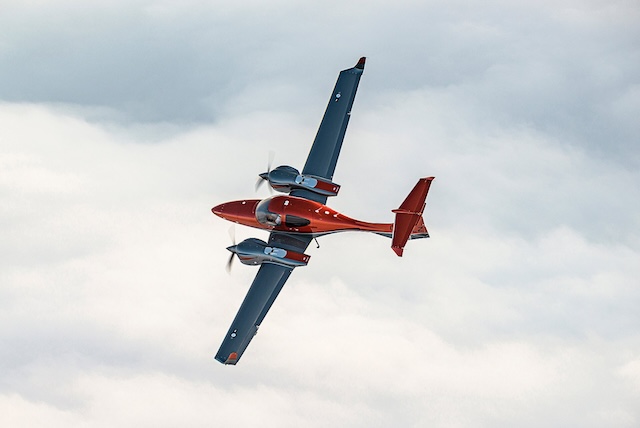DA42 Twin Star
Summary
| Category | Military Training Aircraft |
| Origin country | 🇦🇹 Austria |
| Manufacturer | Diamond |
| First flight | 9 December 2002 |
| Year introduced | 2004 |
| Number produced | 600 units |
| Average unit price | $1.3 million |
Description
Since its founding in the 1980s, Austrian manufacturer Diamond Aircraft Industries had concentrated on building an extensive product line. During the late 1990s, company founder Christian Dries initiated the development of a twin-engined aircraft, marking the company's first venture into multi-engine designs and a step beyond the Diamond DA40. The design emphasized operational simplicity, fuel efficiency, and a luxurious four-seat passenger compartment. The DA42 Twin Star received European Aviation Safety Agency (EASA) certification in April 2004 and Federal Aviation Administration (FAA) certification in July 2005, allowing operations under both visual and instrument flight rules. In August 2004, a DA42 piloted by Gérard Guillaumaud became the first diesel-powered fixed-wing aircraft to perform a non-stop crossing of the North Atlantic. Production was temporarily suspended in July 2008 due to the insolvency of engine manufacturer Thielert, but it resumed in March 2009 after Diamond secured EASA certification for the Austro Engine AE 300, leading to the DA42 NG variant.
The Diamond DA42 Twin Star is a twin-engined low-wing cantilever monoplane, commonly used as a general aviation aircraft for touring and training purposes. It features a retractable tricycle landing gear arrangement and a T-tail. The airframe is composed of composite materials, making extensive use of carbon fiber reinforced polymers throughout its structure. This construction provides the aircraft with a suitable passive safety level to conform with the established European Aviation Safety Agency (EASA) Part 21 rules, as well as relatively efficient aerodynamics and essentially unlimited airframe life; the carbon-fiber main wing spars possesses exceptional crashworthiness. The DA42 typically accommodates four people in two rows of seating. Both the avionics and principal flight controls of the DA42 have been designed to be user-friendly and to reduce pilot workload. A Garmin G1000 glass cockpit serves as the centrepiece of the aircraft's integrated digital avionics, using a pair of large flat-panel monitors in place of conventional instrumentation and gauges. The DA42 is also outfitted with a sophisticated three-axis Garmin-built GFC 700 autopilot and GWX 70 weather radar.
While the standard DA42 is unarmed, certain specialized variants have been adapted for military or surveillance roles, which may include provisions for carrying weapons or specialized equipment. For example, the Rossiyskaya Gazeta announced a UAV version, DA-42B, armed with the 9M120 Ataka antitank missile. The DA42 MPP (Multi Purpose Platform) variant, produced by Diamond Airborne Sensing, is specifically modified to carry aerial sensing, mapping, and surveillance payloads. The Aeronautics Defense Dominator, a UAV version of the DA42, can carry a payload of up to 408 kg (899 lb).
Upon its introduction, the DA42 faced the challenge of reversing a historic decline in light-piston twin sales, amidst increasingly reliable and capable single-engined aircraft. The DA42 found a niche, particularly in the surveillance sector, leading to the development of the DA 42 MPP, a dedicated surveillance model. Notably, during 2008 and early 2009, two Royal Air Force DA42 MPPs provided combat support to coalition forces in Iraq, accumulating 2,000 flight hours equipped with high-definition cameras, laser scanners, and satellite communication equipment. Beyond its use by the Royal Air Force, the DA42 has seen service with the Argentine Army, the Ghana Air Force, the Jamaica Defence Force, the Air Force of Niger, the Polish Air Force, the Russian Federal Security Service, and the Royal Thai Air Force, among others, typically in surveillance or training roles.
Main Variants:
-
DA42: The initial production aircraft, manufactured in both Austria and Canada.
-
DA42 M: A special mission variant, produced in Austria and China, derived from the standard DA42 through modifications or new production.
-
DA42 L360: Equipped with Lycoming IO-360 engines producing 134 kW (180 hp), this version uses 100LL fuel instead of Jet-A1 and is targeted towards the North American flight training market.
-
DA42 NG: Powered by Austro Engine AE 300 127 kW (170 hp) engines, this version received EASA certification in March 2009 and FAA certification in April 2010, with production taking place in Austria, Canada, China, and Russia.
-
DA42 MPP: A "Multi Purpose Platform" variant, modified by Diamond Airborne Sensing to carry aerial sensing, mapping, and surveillance payloads.
Technical specifications
| Version: Dominator II | |
|---|---|
| Operational range | 300 km (186 mi) |
| Maximum speed | 354 km/h (220 mph) |
| Wing area | 16.3 m² (175.3 sqft) |
| Wingspan | 13.4 m (44.0 ft) |
| Height | 2.5 m (8.2 ft) |
| Length | 8 m (26.2 ft) |
| Service ceiling | 9,000 m (29,528 ft) |
| Empty weight | 1,200 kg (2,646 lbs) |
| Max. takeoff weight | 2,000 kg (4,409 lbs) |
| Powerplant | 2 x pistons engine Thielert Centurion 2.0L delivering 100 kW each |
Current operating countries
| Country | Units | ||
|---|---|---|---|

|
Russia | 34 | |

|
Thailand | 32 | |

|
Venezuela | 6 | |

|
Senegal | 4 | |

|
Ghana | 3 | |

|
Poland | 3 | |

|
Jamaica | 2 | |

|
Rwanda | 2 | |

|
Burkina Faso | 1 | |

|
Switzerland | 1 | |

|
Nigeria | 1 | |
All operators
